Table of contents
- Generation comparison Yamaha FZS 600 Fazer / FZ6 Fazer / S2 Ten years of Fazer
- Engine and mileage
- Driving experience, comfort and chassis
- 10 years of Fazer in the test
- 10 years of the 600s Fazer
- Conclusion
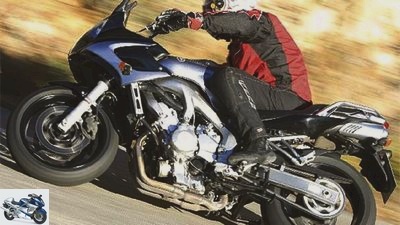
Jahn
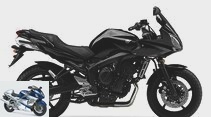
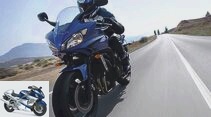
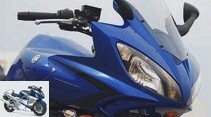
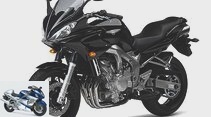
15th pictures
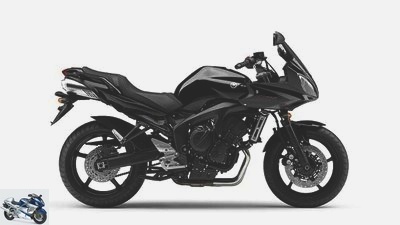
Yamaha
1/15
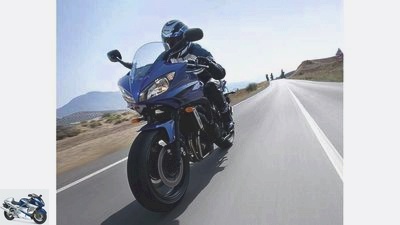
Yamaha
2/15
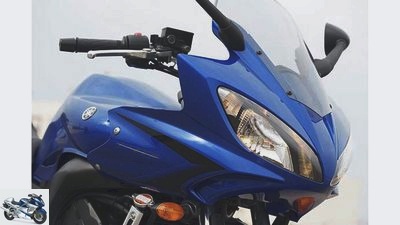
Yamaha
3/15
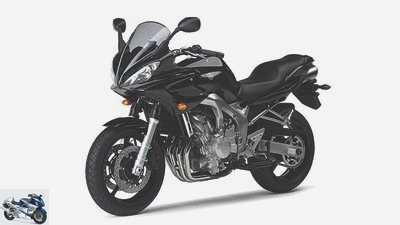
Yamaha
4/15
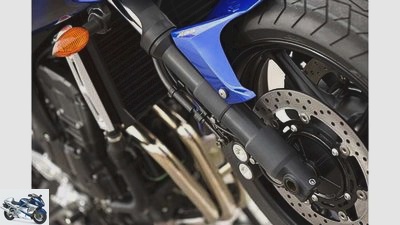
Yamaha
5/15
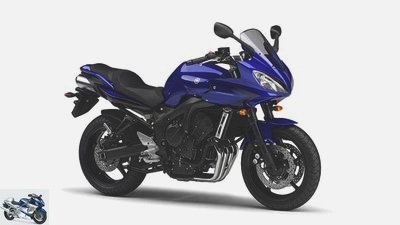
Yamaha
6/15
The slightly more complex S2 version of the Fazer has 98 hp as standard.
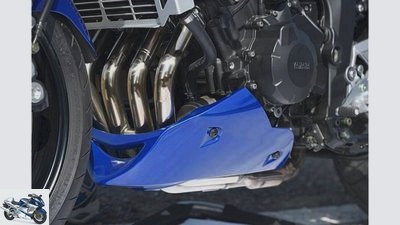
Yamaha
7/15
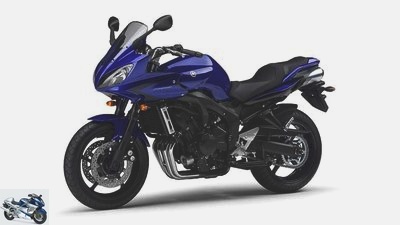
Yamaha
8/15
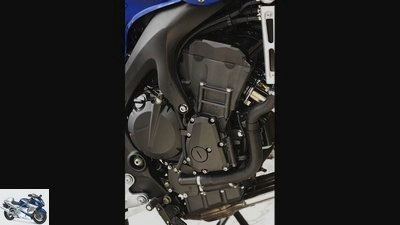
Yamaha
9/15
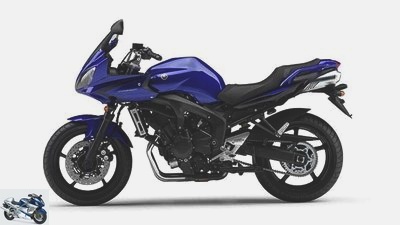
Yamaha
10/15

Yamaha
11/15

Yamaha
12/15
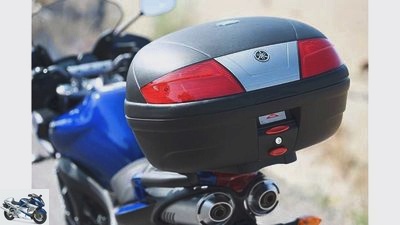
Yamaha
13/15
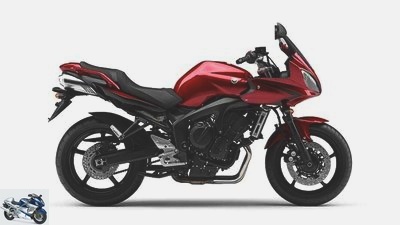
Yamaha
14/15
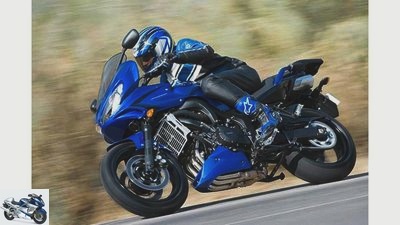
Yamaha
15/15
motorcycles
Generation comparison Yamaha FZS 600 Fazer / FZ6 Fazer / S2
Generation comparison Yamaha FZS 600 Fazer / FZ6 Fazer / S2
Ten years of Fazer
With a powerful, lively engine and a playfully easy to control chassis, Yamaha’s little Fazer demonstrates strength in the 600 class. For ten years.
Norbert Kappes
08/13/2008
When the FZS 600 Fazer saw the light of day in 1998, it hit the market like lightning. No wonder, because there was a huge gap in the Yamaha model range between the XJ 600 S Diversion, a well-behaved, 61 PS strong all-rounder with ambitions suitable for travel, and the YZF 600 R Thundercat, a somewhat overweight, nonetheless awesome, powerful super athlete, the it had to be filled with a sporty all-rounder. The FZS 600 Fazer’s concept of bridging the gap between Diversion and Thundercat was clever. Naughty styled as it was, it basically used the four-cylinder engine of the YZF 600. Yamaha cut a little of the athlete’s peak performance (95 instead of 98 hp) in favor of a fuller torque curve, adapted the brute brakes from the YZF 1000 R Thunderace and packed everything in a half-clad chassis.
Buy complete article
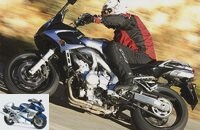
Generation comparison Yamaha FZS 600 Fazer / FZ6 Fazer / S2
Ten years of Fazer
6 pages) as PDF
€ 2.00
Buy now
Today, ten years later, has Yamaha still the 600 Fazer in the program. In its latest version it is now called FZ6 Fazer S2, has 98 hp and cannot deny similarities with the original version. In addition, a low-insurance 78 hp variant is offered without the addition of S2. The chassis is practically identical, and both use the engine technology from the super sports car built in parallel, the YZF-R6, with injection and a regulated catalytic converter. With them, too, the original output of 117 hp has been reduced through modified intake ports, tamer camshaft timing and modified valve springs. A stop on the throttle valve ensures the further reduction in output to 78 hp. How this works, more on that later. The basic principle, tamed sports technique, is the same for all three. How much ?? or how little ?? has changed in ten years, a direct comparison of the Fazer models shows.
Engine and mileage
The lively, willingly starting and mechanically quiet engine of the first Fazer has lost none of its fascination over the years. Barely wider than a briefcase, the compact drive of the FZS 600 still looks fresh and can easily compete with more modern four-cylinder engines of this displacement category. The spontaneously appealing carburettor engine, which is neatly attached to the gas, actually has two lives: Above 8000 rpm it tears violently on the chain, rotates like mad up to its speed limit at 11500 rpm and does credit to a sports engine. Nonetheless, he trots well even at medium revs. Overtaking maneuvers are done in no time, and the thrust is usually sufficient even when exiting a curve. Most of the time, the perfectly coordinated, but somewhat clumsy and noisy gearbox does not have to be tried. An engine that works just as well on the home road as it does on the way to the bakery.
His opponent in the S2, who is ten years younger than him, is less willing to compromise. While on the test bench the difference in the determined peak power, 92 HP for the FZS 600 and 100 HP for the unthrottled FZ6 four-cylinder, is not serious, the type of power delivery differs greatly from one another. The new engine is hotter and livelier. And that has its price. While the old in-line four-cylinder strives consistently and with wonderful uniformity towards its maximum speed and also accelerates more gently, the new injection unit allows itself a respite between 6000 and 7000 and between 8000 and 9000 revolutions ?? in other words, exactly in the area that is often used in practice. The old Fazer can score points when pulling from 100 km / h, while it loses a bit of ground in the sprint and at high revs compared to the new one. Their transmission can also be shifted a little better and less loudly. But as modern as the FZ6 drive is and can shine with better emissions, the fuel consumption is only a little below that of the FZS 600 Fazer. The difference in the MOTORRAD country road measurement is a maximum of 0.3 liters (4.8 to 5.1 liters). On the autobahn at 130 km / h it even ends in a draw.
Driving experience, comfort and chassis

Artist
The Yamaha FZ6 Fazer S2 gets along perfectly with a pillion passenger, even on longer journeys.
Amazingly, the 78 hp variant consumes more than the two unthrottled engines: 5.6 liters per 100 kilometers on the country road. All that remains is the cheaper insurance tariff. Whereby the simple type of throttling causes annoyance in practice. Because the four-cylinder continues to turn bravely into the five-digit range, but without ever being lively. And the performance hole of the S2 in the middle speed range is retained. In contrast, the enthusiasm and sympathy that the FZS 600 Fazer showed over the years is still understandable. After a few hundred meters you feel comfortable on it. Playfully light and yet very neutral, it whets through curves, fascinates with razor-sharp handling and ultimately conveys so much security that you just have to feel safe. Its comparatively narrow tires, 110/70 at the front and 160/60 at the rear, also make the FZS 600 insensitive to ruts and braking in an inclined position. A moment of erection can hardly be felt. Even according to today’s criteria, the four-piston pliers are still awesome: Brute mode of action with extremely fine dosing.
But where there is a lot of light, there is also shadow. Although the sitting position is relaxed and invites you to go on long tours at any time, the angular tank shape is a nuisance and prevents perfect knee closure. It gets very uncomfortable for the passenger. The footrests are placed too high, the extremely narrow knee angle is good at best up to the next ice cream parlor. From model year 2000, however, the pillion seat was improved. What has remained, however, is the rather comfortable suspension set-up. However, the fork has been given an adjustable spring base. Sporty FZS 600 Fazer drivers still criticize the underdamped, not particularly responsive front wheel guidance, and the rear end begins to rock with brisk pace and jagged lane changes. When switching to the FZ6 Fazer, the completely different workstation is immediately noticeable. And it succeeded. You sit ten centimeters higher, but no tank edges interfere with the very good, much tighter knees. It leaves more space for long legs, while the distance to the handlebar ends is pleasantly short. Everything looks very gathered, at the same time relaxed and more active than on the old Fazer.

Artist
At this year’s Alpen Masters, the Yamaha FZ 6 Fazer (second from right) competed against the BMW G 650, Honda Hornet 600 and Suzuki SV 650 S..
There are also big differences in the chassis. A stiff aluminum frame replaces the tubular steel mesh of the FZS 600 and, in combination with more tightly coordinated spring elements, ensures significantly greater cornering stability. A bottoming out of the fork during hard braking maneuvers as well as a guttering tail on fluid, fast passages is alien to the current Fazer. It lies like a board on the street, providing direct feedback. The new one is two kilograms lighter, gives in just as spontaneously as the first Fazer, but then wants to be kept on course. Due to its wider tires, 120/70 at the front and 180/55 at the rear, it noticeably counteracts uneven ground and reacts with a clear righting moment when braking. On the other hand, the S2 and the original model are on the same line when it comes to perfect brakes. Which was not the case in the meantime. The fine, one-piece four-piston calipers gave way in 2004 to bland double-piston calipers, which lacked precise power transmission, which was reflected in the braking performance: 10.5 to 9.9 m / s². Whether the bottom line is the old or the new depends on personal preference: here the all-round talent in the original model, there the sports fan in the current version. Only the 78 hp Fazer is not very convincing when it comes to the engine.
10 years of Fazer in the test
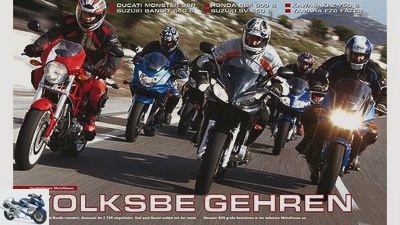
archive
In 2005, the all-round talent had to prove itself in a comparison test.
In a comparison test in 1998 against the larger-displacement, around 100 hp Triumph Speed Triple and Suzuki GSF 1200 S Bandit big bikes, the Fazer was the winner.
On Lake Garda in 2000, she met illustrious companies such as BMW R 850 R, Ducati 750 S, Honda Hornet S, Suzuki SV 650 S and Triumph Legend TT in a comparative test. She won.
It received strong competition in 2002. Honda CB Seven Fifty, Kawasaki ZR-7S and Suzuki GSX 750 F were the names of their opponents, which they were clearly superior to in the group test.
In 2005, the Fazer had to prevail against Ducati Monster S2R, Honda CBF 600 S, Kawasaki Z 750 S, Suzuki SV 650 S and Bandit 650 S. No problem for the clever all-rounder.
10 years of the 600s Fazer
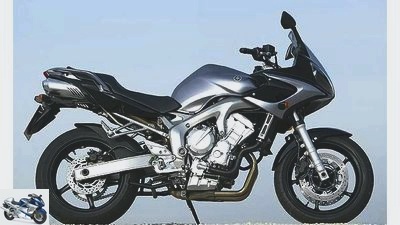
archive
In 2004, a stable, two-part aluminum frame replaced the old tubular steel mesh.
1998
The success story of the FZS 600 Fazer began ten years ago. In the first year, the Fazer sold 3,060 times. In the following year, the 95 hp, half-clad all-rounder recorded a further 3233 new registrations.
2000
Yamaha responded to the criticism of the pillion suitability and moved the muffler mounting 17 millimeters down, so that the pillion pegs can be attached 45 millimeters lower. In the same way, the rear seat bench is raised by 16 millimeters. To improve shiftability, the deflection on the shift lever is lengthened by four millimeters. The cockpit will be fitted with a clock and two trip meters, and a hazard warning system will be installed. A modified tank shape increases the volume from 18 to 20 liters. The handlebars, which are a little higher but are narrower, have also been modified. The fork is upgraded with an adjustable spring base. The new registrations increase to 3665 units. In 2001 there were only 2757 Fazers sold.
2002
After four years, a facelift is due for the first time in the form of a newly designed front fairing and cockpit. At the same time, new headlights improve the light yield. The tank, which has been modified again, now holds 22 liters. Mirrors matched to the cladding ensure better consideration, and the hand levers can be adjusted to five instead of four positions. The outer exhaust manifolds and the transition to the silencers are now made of stainless steel. An alternator with a higher output power (290 watts) is used. With 3492 new registrations, the Fazer is making good progress again and is only slightly below that in 2003 with 3294 units sold.
2004
The FZS 600 Fazer becomes the FZ6 (uncovered) and the FZ6 Fazer. The 98 hp, now water-cooled, electronic injection engine comes from the YZF-R6. Particularly attractive and sporty at the same time: the underseat exhaust system instead of the four-in-one guided on the side. In addition, a stable bridge frame made of aluminum instead of a tubular steel frame. The central spring strut is directly hinged, the adjustable rebound stage damping is omitted, the tires are fatter at the front and rear. The 17-inch rear wheel is still guided by an aluminum swing arm. Double-piston floating calipers replace the four-piston calipers of the front brake. A single-piston floating caliper instead of a two-piston fixed caliper is sufficient for the rear. The tank content now goes backwards: 19.4 liters. And the cockpit receives digital instruments. Record: 3871 FZ6 Fazers find an owner. In 2005 a further 3307 new registrations are listed.
2006
The Fazer is upgraded with a standard ABS, which is initially not available for the bare FZ6. The aluminum frame is anodized in black, and the engine is black instead of the previous silver. 3010 buyers can warm up to the FZ6 and FZ6 Fazer in total.
2007
As an S2 model, the FZ6 Fazer has again received optical retouching. In addition, the new, cast aluminum swing arm has a more precise axis guide. From the point of view of most drivers, the rev counter, which is now analog again, is easier to read. One-piece four-piston calipers for the double disc brake improve the braking behavior. The seat has a slimmer contour in the tank area and has a more comfortable foam padding and a better-grip cover. Unchanged in the range are the FZ6 Fazer and FZ6 with an output that has been reduced to an insurance-favorable 78 hp. But they can also be dethrottled again. In 2007, the three Fazer models sold a total of 3460 times. In 2008 there are 1873 units so far.
Conclusion
Very easy handling, comfortable suspension set-up, lively, cultivated engine, great brakes. An all-round talent until Yamaha made a cut with the 2004 vintage. The 600 Fazer became sportier, received a significantly firmer, more stable chassis ?? and top brakes on the S2 model.
Related articles
-
Comparison test BMW K 1300 R, Buell 1125 CR, Suzuki B-King, Yamaha Vmax
K 37 pictures Yamaha 1/37 First look at the device from all sides… Yamaha 2/37 Yamaha 3/37 Yamaha 4/37 Yamaha 5/37 Yamaha 6/37 Yamaha 7/37 What is…
-
Comparison test between Suzuki DL 1000 V-Strom and Yamaha TDM 900
Artist motorcycles Comparison test between Suzuki DL 1000 V-Strom and Yamaha TDM 900 Comparison test between Suzuki DL 1000 V-Strom and Yamaha TDM 900…
-
Comparison test Kawasaki Ninja ZX-6R, Triumph Daytona 675, Yamaha YZF-R6
Fact 9 pictures triumph 1/9 Triumph Daytona 675 triumph 2/9 Triumph Daytona 675 triumph 3/9 Triumph Daytona 675 triumph 4/9 Triumph Daytona 675 triumph…
-
Comparison test Yamaha FZS 1000 Fazer-R1 and Honda Hornet S-CBR 600 F
Jahn motorcycles Super athlete Comparison test Yamaha FZS 1000 Fazer / R1 and Honda Hornet S / CBR 600 F Comparison test Yamaha FZS 1000 Fazer / R1 and…
-
fact motorcycles Comparison test: Honda CBR 600 RR, Kawasaki ZX-6R, Suzuki GSX-R 600, Triumph Daytona 675, Yamaha YZF-R6 Comparison test: Honda CBR 600…
-
Comparison test MV Agusta Turismo Veloce 800 and Yamaha MT-09 Tracer
Bilski 19th pictures MOTORCYCLE 1/19 Power on the crankshaft. Measurements on the Dynojet roller test stand 250, corrected according to 95/1 / EG,…
-
Bilski motorcycles Comparison test: KTM 990 Super Duke, Moto Morini Corsaro 1200 Veloce, Triumph Speed Triple, Yamaha FZ1 Comparison test: KTM 990…
-
Comparison test: Honda CBF 1000 Silverline, Suzuki Bandit 1250 S, Yamaha FZ1 Fazer
Jahn 22nd pictures Honda 1/22 Honda CBF 1000 Honda 2/22 Honda CBF 1000 Zdrahal 3/22 Presentation at the fair in Paris. Honda 4/22 Honda CBF 1000 Honda…
-
Comparison test: Yamaha YZF-R6 in three expansion stages
Jahn motorcycles Comparison test: Yamaha YZF-R6 in three expansion stages Comparison test: Yamaha YZF-R6 in three expansion stages R6 series vs. Cup vs….
-
Comparison test Honda CBF 125 against Yamaha YBR 125
fact motorcycles Comparison test Honda CBF 125 against Yamaha YBR 125 Comparison test Honda CBF 125 against Yamaha YBR 125 Inexpensive 125cc singles No…